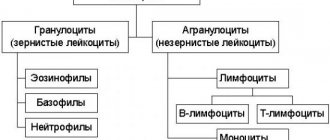Childbirth is behind you - and you finally saw your baby. Now he is an independent being. How are the first minutes of his life going? An obstetrician-gynecologist with 30 years of experience will tell you about everything that should happen in the maternity hospital.
Left behind are childbirth and the long period during which you and the baby were practically one. You have already seen your child, held him in your hands, and have even gotten a little used to the idea that he is now an independent being, and from now on, different specialists will take care of his and your life.
Gradually, the only important question is “Is everything okay with my baby?” is supplemented by a number of others, and most of them relate specifically to the child. Questions regarding one’s health and condition arise either if something goes wrong, especially if there is a prospect of a stay in the hospital, or if the mother’s very feelings make her worry about whether she has the strength to cope with the baby at home, where there is no professional assistants - doctors and nurses.
- What manipulations does the child undergo immediately after birth?
- Should I worry if my child scores lower on the Apgar scale? What does this threaten him with?
- Modern experts advise putting the baby to the breast immediately after birth, is this really so important?
- Is it possible to put a baby to the breast after a caesarean section?
It's not scary what's scary
“In fact, everything is not as scary as it seems to you,” says Baibarina, “you were taught a lot at the school of motherhood even before giving birth, and in the maternity hospital - after all, there you already held the child in your arms, fed it, and maybe even understood, why is he crying". But, left alone with the baby, many still feel fear. This concern for your own child is part of the maternal instinct
. It is one of the factors that allows humanity to survive.
Breast-feeding
Are you breastfeeding? We tell you how to prepare for feeding, how to avoid possible difficulties, how to feed a nursing mother herself, and how to structure the nutrition of children under one year old.
You have to get used to the fact that fear for your own child will never leave your mother. You must learn to live with him, without giving him the opportunity to gain the upper hand and give rise to overprotection syndrome. Everything should be in moderation.
Features of the structure of the baby's body
While the baby is getting used to the new conditions of existence, his body, which is not yet fully developed, works differently from that of adults. The first days and first week of a baby’s life are a time of restructuring and adaptation in his body, which is why his organs are so delicate and sensitive to the influence of all kinds of environmental factors.
- The first week of development may bring jaundice, which will soon subside.
- The second week is the time for the umbilical wound to heal.
- In the third week, the baby listens and fixes his gaze.
To understand and properly care for a newborn, you need to know the structural features of a small organism.
New mothers are constantly worried about their babies; they are frightened by almost everything that happens to them. In order to avoid this fear, you should better know the structure and characteristics of the body of newborns.
Leather
His skin is too thin and vulnerable, there are many capillaries under the skin, he breathes intensely through his pores. Thin skin does not yet know how to protect it from temperature changes. Therefore, the baby quickly turns red or pale, the slightest touch can hurt and lead to diaper rash.
Muscles
The muscles and ligaments are weak and do not know how to interact, so the baby still moves little and carefully. If you do not swaddle, the baby tries to assume the fetal position. She is understandable and familiar to him. Tense legs and arms are pressed against the tummy, the head does not hold up and leans towards the chest.
Skeletal system
A child is born with a fully formed skeleton and soft, pliable bones, otherwise he would not have passed through the birth canal. The bones of the skull are not yet connected to each other, moving on top of each other so that at birth the head passes out.
Therefore, sometimes in newborns the head has a somewhat elongated shape, but the natural shape of the head is soon restored. The so-called children's fontanels, large and small, remain unprotected for a long time.
Parents need to protect the fontanelles, carefully monitor them, do not injure them, do not put pressure on them. Normally, they are covered with bones by one year or a little later.
Respiratory system
The respiratory organs have not fully formed, so the newborn breathes quickly, superficially, and unevenly. For the development and growth of the body, the baby needs a lot of oxygen, so inhalation and exhalation occurs almost every second. The narrow larynx and short nasal passages are covered with loose mucous membrane, which quickly reacts to heat and cold.
Circulation
In order to pump large amounts of oxygen and deliver it to every organ, the circulatory system has to work under overload. The tiny heart (relative to the body, the heart of an adult is much larger) contracts and pushes blood at a speed of up to 140 beats per minute. When the baby tenses up and cries loudly, the pulse can reach 200 beats per minute.
Digestive organs
A person is born adapted to suckle. Sucking rollers on the lips easily grab the breast and suck mother's milk. Teeth begin to cut after six months. The mucous membrane covering the mouth is vulnerable and susceptible to infections.
The gastrointestinal tract is not yet fully formed, the esophagus is very short, the muscles of the intestines and stomach are weak, the ventricle is the size of a fist. Looking at the baby's fist, the mother can understand how much milk per feeding is needed to satiate her.
Frequent infant regurgitation after feeding occurs because the valve that closes the entrance from the esophagus to the stomach is not sufficiently developed. Two to three times a day, the intestines are emptied with soft, light yellow-brown stool. If emptying does not occur, parents should sound the alarm and consult a doctor.
Genitourinary system
The newborn’s urinary organs are formed, urination is a reflex, up to 25 times a day. Urine is odorless, transparent, there is not much of it, because the bladder is still small. Excessive urination may indicate inflammation and be a reason to consult a doctor.
The external genitalia are formed at birth, but due to loose mucous membranes they require cleanliness and care.
Nervous system
The nervous system, although underdeveloped, performs basic functions. Unconditioned reflexes are in human nature, so he knows how to suck, blink, and grab from birth. There is vision and hearing, but the baby still cannot distinguish between individual objects and individual sounds. But taste, smell, and tactile receptors work from the first days.
If future parents carefully prepare (including informationally) for the birth of their child, then they will not have any problems. And if they arise, they will be able to quickly navigate and solve them. Remember, the “newborn” period passes very quickly, but these first days, when the baby is still so dependent on mommy, will never be forgotten.
How to avoid freezing a child?
You have arrived home, where a corner has already been prepared for the child, all his things are laid out - diapers, clothes, nappies and care products. There should be no drafts in the room, but at the same time it is better to maintain the air temperature at 22-24 degrees
Celsius. To do this, ventilate the room regularly, but try not to use heaters. They dry out the air, and it becomes uncomfortable for the baby’s delicate nasopharynx mucosa. You can check if your baby is cold by touching the tip of his nose or forearm. If these places are not cold to the touch, the child is quite comfortable. Make sure that your newborn's clothes do not become wet, and that beads of sweat do not appear on the tip of the nose - these are signs that the baby is hot.
What problems can you encounter in the first days?
Colic. 100% of parents will face this problem. Colic is bloating and pain in a baby's tummy. The problem can be troublesome during the first months of life. It cannot be prevented; you just have to endure it. But the condition can be alleviated. If a child cries for no apparent reason, kicks his legs, or worries, he most likely has colic. You can confirm this yourself - touch your tummy. If it's hard and swollen, it's definitely them. You can fight them in three ways.
- Warmth on the tummy. To facilitate the passage of gases, you need to put the baby on a warm diaper (iron it with an iron), or put a warm heating pad on the tummy.
- Massage. Gently stroke the tummy in a clockwise circular motion without pressing. This will improve motor skills and help improve the passage of gas.
- Medicines and folk remedies. Among medications, the most common is Espumisan drops. If you don’t have it, you can replace it with dill water - pour the dill seeds with hot water, cool and give half a teaspoon to the baby every five minutes. You can also pour it into the cheek from a syringe (without a needle) of 2.5 ml.
With any of these products it is worth using a gas outlet tube. You can do it yourself - cut off the nose from a small pear (enema). The gas outlet tube must be lubricated with vegetable oil at one end and carefully inserted into the anus with a screwing movement of 1–2 cm.
Thrush (candidiasis) . Manifestations of candidiasis in children are a white coating on the mucous membranes. In newborns, these are mainly the mucous membranes of the oral cavity - the palate, the cheeks. When they appear, you should contact a visiting nurse or doctor. You can treat the oral cavity yourself with a weak soda solution (1 tsp per 300 ml of water) or Candide solution. The thrush should go away within 3-5 days.
Problems with stool. In the first days of a newborn at home, he may suffer from constipation. This is due to the need to adapt the digestive tract to milk. It is worth remembering that constipation is the retention of stool for more than a day. Solid consistency is not constipation. Stool retention is eliminated by an enema. 150 ml of warm water is injected into the rectum. This will help cleanse the intestines. If this does not help, you should consult your pediatrician for advice.
Weakening of the stool may be due to a violation of the mother's diet or congenital enzyme deficiency. Another reason is an intestinal infection. The initial link in diagnosis is the local pediatrician. This is the one you should go to first.
In order to provide the baby with proper care and comfortable conditions in the first days of his stay at home, it will not be superfluous to familiarize yourself with special perinatal literature and carefully prepare for the baby’s arrival: make the home a safe environment for the life and development of the little man. A newborn should receive everything he needs, and in the quantity required. The child expresses his needs in the form of crying or worry. You need to remember this and react in time.
With careful preparation, the right approach and love, your baby's first day at home will be the first day of a truly happy family life. And the new person will grow up to be a full-fledged and healthy member of society.
Author: Sukhorukova Anastasia Andreevna, pediatrician
Video tips for caring for a newborn
We recommend reading: Hypogalactia in a nursing mother. What to do if there is not enough milk
Author
Anastasia Sukhorukova
Pediatrician
Has a higher medical education. Specializations: pediatrics, obstetrics and gynecology, psychiatry, general therapeutic issues and orthopedics.
Share
What to wear?
Put a diaper and sleepsuit (overalls) on your child - in such clothes the baby can move his arms and legs freely
.
This contributes to his physical development and even helps to relieve gases, from which children suffer so much in the first months of life. If you decide to swaddle your baby, do not forget about the basic rules of swaddling
: do not do it too tightly so as not to hinder the movement of the legs inside the diaper.
In addition, the diaper should end at the level of the baby's armpits - this will allow him to move his arms. “The need to swaddle tightly, in a column, supposedly to prevent curvature of the legs, is a misconception of our great-grandmothers,” explains Baibarina. - Legs become crooked from rickets. But movement, on the contrary, is an excellent prevention of such problems.” For the first time, you can put on a newborn blouse or vest with sewn-up sleeves or special mittens - “scratchers” - which will prevent the baby from accidentally scratching his face. In the first year of life, the baby does not need a pillow
- it is better for him to lie on a flat surface. Place a diaper folded in four under his head - if the baby burps, it can be easily replaced with a clean one. Cover the child with a small blanket that is not too hot.
Until the first cry...
During the first seconds after birth, the child is almost completely immobilized, does not perceive sound and light, does not respond to painful stimuli, his muscles lack tone, and no reflexes are evoked. This state is called “birth catharsis,” which translated from Greek means “purification.”
This happens due to the colossal amount of a wide variety of sensations and stimuli that befall the child in the last moments of childbirth. A protective mechanism is triggered to prevent information shock. A fetus that has been in the womb for nine months suddenly finds itself in completely different conditions. Instead of a constant temperature of 37°C, the temperature of the room seems very low to the child, and he needs to adapt to it. Instead of the aquatic environment that constantly surrounded him, there was air that he had to learn to breathe. Instead of weightlessness there is the force of gravity, to which you need to get used. It was dark - and now there is bright light around! It was quiet - and now there is a flurry of a wide variety of sounds! In those seconds that pass between birth and the first cry, the baby is in a special state.
To protect a tiny, newly born creature from shock, evolution created this protective state - a state of non-reaction to external stimuli. Birth catharsis lasts very briefly and ends at the moment of crossing the umbilical cord. At the moment when the obstetrician’s hand cuts this channel connecting mother and child, its life begins as an independent organism. As soon as the blood flow through the umbilical cord vessels is interrupted, the baby takes his first breath. This is facilitated by the fact that during the last minutes of labor, the proportion of carbon dioxide in the fetal blood increases, and the oxygen concentration decreases significantly, which has an irritating effect on the respiratory center located in the child’s brain. A powerful impulse comes from this center, signaling increasing hypoxia (lack of oxygen), and the child screams loudly, taking the first breath in his life. His lungs, filled with fluid throughout the entire period of intrauterine development, expand, fill with air and begin to carry out one of the main life-supporting functions - breathing.
At the same moment, the pulmonary circulation begins to function, which, due to its uselessness, did not work for all nine months. Its purpose is to transport oxygen-rich blood from the lungs to the heart and carbon dioxide-rich blood from the heart to the lungs. Since the fetal lungs are inactive during intrauterine life, the pulmonary circulation does not function. Instead, there are channels (shunts) that are characteristic exclusively of the fetal circulation - the oval window between the right and left atria, the ductus arteriosus between the aorta and the pulmonary artery. These shunts stop functioning gradually over several hours and sometimes days. But their existence no longer plays any role in blood circulation. Their presence is one of the manifestations of the transitional state from intrauterine life to extrauterine existence. It is their presence that can explain the bluish coloration of the limbs of a newborn in the first hours after birth.
Brought it home and...
When you just arrive home from the hospital, undress your baby, change his diaper and put on clean home clothes. If the child is hungry, feed him. Pediatricians recommend breastfeeding on demand
- not according to a schedule, but when the baby is hungry and wants to eat. It is best to feed your baby while sitting, always with back support. This can be done in a chair or on a bed with pillows under your back. When the baby has eaten and falls asleep, go to rest yourself - your body still needs recovery after childbirth. “Besides, it is unknown how much sleep you will be able to sleep the next night,” notes Baibarina. It would be right if happy relatives do not organize a big feast at home. It is better to postpone congratulations to young parents for some time to allow the family and baby to adapt to the new life.
Feeding a newborn
Feeding a child is a separate huge stone in the foundation of your baby’s life. Therefore, we have allocated it to a special section.
Article: Starting breastfeeding
The first thing that worries young mothers is how to properly attach their baby to the breast. Proper technique will help avoid cracked nipples and other breast problems.
Article: Attachment to the breast
Article: Feeding positions
Article: Cracked nipples
Next, all mothers really want to make sure that the baby is fully fed and does not remain hungry:
Article: Does the baby have enough milk?
Many mothers who have chosen their mother or grandmother as their leader are faced with the problem of whether to feed the child on demand or on a schedule? And also: should I express the remaining milk after feeding or not?
Article: Expressing breast milk
Will my breasts be able to produce as much milk as my baby needs? This misconception often worries mothers with small breasts. To dissuade him, read the article When a mother has little milk.
And for those who have too much milk, so that the baby does not have time to suck it out, in the first days breast pain and swelling may begin - lactostasis. This is where a manual or electric breast pump can come to the rescue.
And almost everyone is afraid, how will the baby grow when he spits up almost everything he eats?
Article: Regurgitation
Most new mothers are healthy enough to breastfeed their baby. But if for some reason she loses milk, the child has to be transferred to artificial feeding.
The most important
Fear for a child is a completely natural feeling for a young mother.
But the baby does not require greenhouse conditions, he does not need a hot heated room and a down pillow. A newborn feels most comfortable at a temperature of 22-24 degrees, lying in a crib without a pillow. And as the first clothing you should choose something that does not restrict movement. Tags:
- Breast-feeding
- Safety
- Babies
To leave a comment you must be an authorized user
Genitals
They may look unnaturally large at first. In 60-70% of newborns (both boys and girls), a hormonal crisis may occur on the third or fourth day - under the influence of the mother’s hormones still in the child’s body. It is expressed in engorgement of the mammary glands; when pressed, a liquid similar to colostrum is released from them. Girls have copious mucous discharge from the vagina (sometimes bloody), while boys have darker skin around the nipples and scrotum. The sexual crisis usually goes away without treatment. Under no circumstances try to squeeze fluid out of the nipples, as this can lead to mastitis.











